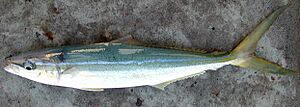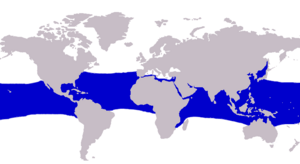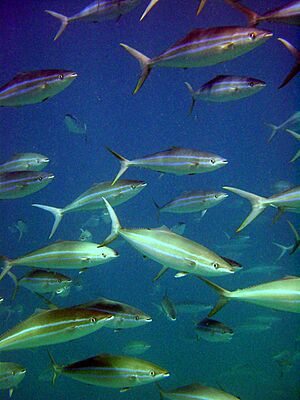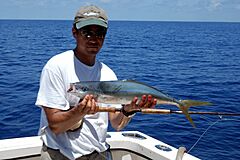Rainbow runner facts for kids
Quick facts for kids Rainbow runner |
|
|---|---|
 |
|
| Conservation status | |
| Scientific classification | |
 |
|
| Approximate range of the rainbow runner | |
| Synonyms | |
|
The rainbow runner (Elagatis bipinnulata) is a colorful fish found in oceans around the world. It's also called the rainbow yellowtail, Spanish jack, or Hawaiian salmon. This fish belongs to the jack family, known as Carangidae. Rainbow runners live in tropical and subtropical waters, both near the coast and far out in the open ocean.
This fish is the only member of its group, called Elagatis. It's related to other fish like the amberjack. You can easily spot a rainbow runner by its unique body shape and bright colors. It's a very fast swimmer and hunts smaller fish, squid, and tiny ocean creatures called crustaceans. Rainbow runners grow to about 60 centimeters (2 feet) long before they can have babies. They can lay eggs at different times, with some groups spawning all year. This fish is popular for fishing and is also good to eat. Many are caught by accident when people are fishing for tuna or sharks.
Contents
About the Rainbow Runner Fish
The rainbow runner is the only fish in its special group, Elagatis. This group is part of the larger jack family, Carangidae. French scientists Jean René Constant Quoy and Joseph Paul Gaimard first described this fish in 1825. They found it in the Indian Ocean.
They first thought it was related to amberjacks and named it Seriola bipinnulata. Later, scientists realized it needed its own unique group. The name Elagatis was given to it in 1840 by Frederick Debell Bennett. The name "rainbow runner" comes from its amazing colors. It has many other local names around the world, too.
What Does a Rainbow Runner Look Like?
Unlike many jacks that have flat, deep bodies, the rainbow runner has a long, sleek body. It's shaped like a torpedo, with a pointed head and a tail that gets thinner. Its eyes are small, and it has tiny teeth in its mouth.
This fish has two dorsal fins on its back. The back part of the second dorsal fin is separated into a small finlet. It also has a finlet on its belly, like the dorsal fin. The fins on its sides (pectoral fins) are small. Its tail fin is deeply forked, which helps it swim fast. The rainbow runner has about 100 scales along its side.
The colors of the rainbow runner are its most famous feature. Its upper body is a dark olive-blue or green. This color fades to white on its belly. Two thin, light blue stripes run along its sides. Between these blue stripes, there's a wider olive or yellow stripe. Most rainbow runners grow to be about 107 to 120 centimeters (3.5 to 4 feet) long. The heaviest one ever recorded weighed 46.2 kilograms (101.9 pounds).
Where Do Rainbow Runners Live?
Rainbow runners live in warm, tropical, and some subtropical waters all over the world. You can find them in the Western Atlantic Ocean, from Massachusetts down to Brazil. They also live throughout the Pacific Ocean. In the Indian Ocean, they are less common.
These fish mostly live in the open ocean, up to 164 meters (538 feet) deep. They sometimes come closer to land, near rocks and coral reefs. Young rainbow runners have even been seen in river mouths in Taiwan. Like other jacks, rainbow runners are often attracted to special floating devices called FADs (Fish-Attracting Devices). They treat these devices like stationary objects in the ocean.
Rainbow Runner Biology and Life Cycle
Rainbow runners often swim in groups, from a few fish to hundreds. They also travel long distances. Their muscles have a lot of a special fat called docosahexaenoic acid. This helps them swim for a long time, similar to how tuna can migrate far.
What Do Rainbow Runners Eat?
Rainbow runners are fast hunters. They eat many different things. Their diet includes small fish, squid, and tiny ocean creatures like shrimp and crabs. In the Pacific Ocean, they especially like to eat a small fish called Decapterus macarellus. As they grow, rainbow runners become even better at finding their favorite foods. They also eat sea-skaters, which are insects that live on the ocean surface.
Bigger animals also hunt rainbow runners. These include Fraser's dolphins and certain seabirds.
Reproduction and Growth
Female rainbow runners can start having babies when they are about 60 centimeters (2 feet) long. Males are thought to be ready around the same size. In the Atlantic Ocean, they usually lay eggs from spring to early autumn. However, in warmer waters (above 27°C or 80°F), they can lay eggs all year. Even then, they have peak times for spawning, like in May and December-January in the Western Pacific.
They lay eggs that float in the open ocean. Scientists have studied the baby fish (larvae) to learn how they grow. At one year old, a rainbow runner is about 30 centimeters (1 foot) long. By five years old, it can be around 77 centimeters (2.5 feet) long. Young rainbow runners sometimes float in ocean currents under large mats of seaweed called Sargassum.
How Humans Use Rainbow Runners
Rainbow runners are not a main commercial fish like tuna. But many are caught by accident when people are fishing for tuna or sharks. Their meat is considered good to eat, but they don't sell for a high price because they are not as well known. Ancient people on islands in Micronesia caught many rainbow runners for food. They likely used lure hooks from their canoes.
Commercial Fishing for Rainbow Runners
Rainbow runners are rarely the main target for commercial fishing. However, large numbers are caught as "bycatch" in tuna and shark fisheries. For example, between 1985 and 1994, about 720 to 1,877 tons were caught each year in the West Indian Tuna Fishery. Global catches reached a high of 18,940 tons in 1998. This bycatch is almost always kept and sold fresh, salted, or frozen. Fishermen usually catch them using large nets called purse seines or with hooks and lines.
Recreational Fishing for Rainbow Runners
Some people enjoy fishing for rainbow runners as a hobby. Anglers often catch them while trying to catch other fish like tuna. But they also target rainbow runners closer to shore, especially on the west coast of the Americas. Fishermen use many different lures and baits, including deep-diving lures, surface lures, and even saltwater flies. They also bite on live or cut fish, squid, and octopus. Rainbow runners are known as strong fighting fish, especially the bigger ones. They are also used as bait for catching even larger fish like billfish and tuna.




